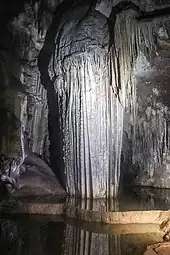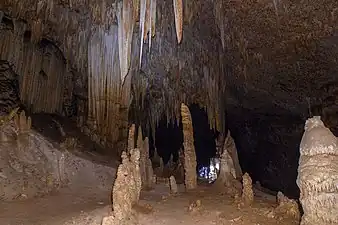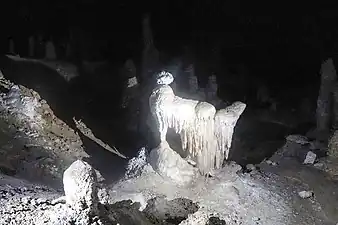Hoq Cave
The Hoq Cave or Hawk Cave (Arabic: كهف هوق) is a limestone cave on the island of Socotra, Yemen. It is located in the Hala spot approximately 1.5 km from the north-eastern coast facing the open sea to north-east. Clearly visible from the sea, but of difficult access, it is situated in an altitude of 350 m. The about 2 km deep cave has a main passage with a mean width of 50 m and a mean height of 20 m. 200 m from the entrance is the limite d’éclairement. The temperature is constant during the year and varies between 25 and 27 °C with a humidity higher than 95%.[1]
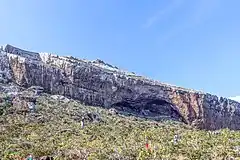 | |
 Location on Socotra 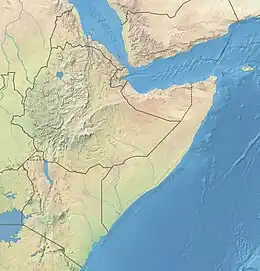 Hoq Cave (Horn of Africa) | |
| Region | Socotra |
|---|---|
| Coordinates | 12°35′11″N 54°21′15″E |
All sorts of speleothems, where numerous endemic troglobionts are living, can be found along the way into the cave.
A range of epigraphy from the 1st to the 6th century A.D. has been recorded in the back part of the cave placing Socotra as a major hub in the overseas trading links in ancient times where merchants from all coasts of the northern Indian Ocean were brought together.[2]
Protection
The cave is a protected area under the law. To conserve the cave a pathway has been constructed. The end of the cave is still under study for future archaeological investigations.[3]
Description
In 2001 a group of Belgian speleologists from the "Socotra Karst Project" mapped and investigated the cave finding numerous graffitis and drawings on speleothems and floors.[4][5] Subsequent research concluded that they were the work of navigators or merchants who visited the island at the beginning of the first millennium. The corpus of inscriptions is in Indian Brahmi, South Arabic, Ethiopian Geʽez, Ancient Greek, Palmyrene, and Bactrian scripts.[6] All the inscriptions are rather short containing personal names, hometowns, professions, or ethnic and religious affiliations.[7]
Gallery of speleothems
See also
References
- Exploring the Hoq Cave Retrieved 17 February 2023.
- Evers, Kasper (2014–15). "Cave of Revelations: Indian Ocean Trade in light of the Socotran Graffiti". Journal of Indian Ocean Archaeology. 10–11: 19–37.
- Strauch, Ingo (2019). Buddhism in the West? Buddhist Indian Sailors on Socotra (Yemen) and the Role of Trade Contacts in the Spread of Buddhism, In: Buddhism and the Dynamics of Transculturality. De Gruyter. pp. 15–52. ISBN 9783110411539.
- "La grotte sanctuaire de Suqutra". Archéologia (in French). 396. January 2003.
- Robin, C.; Gorea, M. (January 2002). "Les vestiges antiques de la grotte de Hôq (Suqutra, Yémen) (note d'information)". Comptes rendus des séances de l'Académie des Inscriptions et Belles-Lettres (in French). 146 (2): 409–445. doi:10.3406/crai.2002.22441.
- Bukharin, Mikhail D.; De Geest, Peter; Dridi, Hédi; Gorea, Maria; Jansen Van Rensburg, Julian; Robin, Christian Julien; Shelat, Bharati; Sims-Williams, Nicholas; Strauch, Ingo (2012). Foreign Sailors on Socotra. The inscriptions and drawings from the cave Hoq. Bremen: Dr. Ute Hempen Verlag. p. 592. ISBN 978-3-934106-91-8.
- Bukharin, Mikhail; Strauch, Ingo (2004). "Indian Inscriptions from the Cave Hoq on Suqutra (Yemen)". Annali Istituto Universitario Orientale. 64: 121–138.
